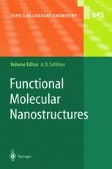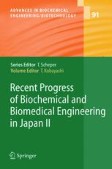Search
Search Results
-
Cell-free Protein Synthesis Systems: Increasing their Performance and Applications
The Escherichia coli cell-free protein synthesis system can now be used for various proteins that need special requirements, such as disulfide bond...
-
DNA Electron Transfer Processes: Some Theoretical Notions
Charge motion within DNA stacks, probed by measurements of electric conductivity and by time-resolved and steady-state damage yield measurements, is...
-
Functions of Rab GTPases in organelle biogenesis
Rab GTPases regulate diverse aspects of the biogenesis of secretory and endocytic organelles. The conformational changes that accompany GTP binding...
-
Equilibrium Structure of Dendrimers – Results and Open Questions
We review the problem of the structure of dendrimers in solution. Special emphasis is placed on recent theoretical work and computer simulations of...
-
A Covalent Chemistry Approach to Giant Macromolecules with Cylindrical Shape and an Engineerable Interior and Surface
This article divides the synthetic routes leading to dendronized polymers into two main categories (attach-to and macromonomer) and compares their...
-
Insect Chemical Defense
Research on the defensive chemistry of insects during the last decade is reviewed, with special emphasis on non-volatile compounds. The isolation and...
-
Aminoglycoside–Nucleic Acid Interactions: The Case for Neomycin
Aminoglycoside antibiotics are bactericidal drugs that have been at the forefront of antimicrobial therapy for almost five decades. The past decade...
-
Artificial Host Molecules for the Sensing of Anions
The foundations of supramolecular complexation of anions by abiotic host compounds are evaluated, with the purpose of determining their qualitative...
-
Monitoring Multidrug Resistance P-Glycoprotein Drug Transport Activity with Single-Photon Emission Computed Tomography and Positron Emission Tomography Radiopharmaceuticals
Multidrug resistance (MDR) mediated by overexpression of MDR1 P-glycoprotein (Pgp) is one of the best characterized transporter-mediated barriers to...
-
Fluorescence Lifetime Imaging Microscopy (FLIM)
Fluorescence lifetime imaging microscopy (FLIM) is a technique to map the spatial distribution of nanosecond excited state lifetimes within...
-
Spectral Imaging and Linear Unmixing in Light Microscopy
Fluorescence microscopy is an essential tool for modern biological research. The wide range of available fluorophores and labeling techniques allows...
-
Diphtheria toxin, diphtheria-related fusion protein toxins, and the molecular mechanism of their action against eukaryotic cells
Diphtheria toxin remains one of the most successfully studied of the bacterial protein toxins. A detailed understanding of the structure function...
-
Recent Advances in the Chemistry of Difunctionalized Organo-Phosphorus and -Sulfur Compounds
Recent results related to the synthesis and reactivity of organocompounds substituted by both phosphorus and sulfur functional groups are reviewed....
-
Model-based Inference of Gene Expression Dynamics from Sequence Information
A dynamic model of prokaryotic gene expression is developed that makes considerable use of gene sequence information. The main contribution arises...
-
Scanning Probe Microscopy Studies of Surface-Immobilised DNA/Oligonucleotide Molecules
Although most in vivo biomolecular recognition occurs in solution, in many practical situations (e.g., diagnostics, drug discovery and biosensing)...
-
New Phosphorylated Hosts for the Design of New Supramolecular Assemblies
Development of chemistry around new phosphorylated hosts provides an interesting new area of investigations in the design of host-guest systems....
-
Complexes with a Metal-Phosphorus Triple Bond
A survey of the existing complexes containing a transition metal-phosphorus triple bond is presented. Based on the different types of these...
-
Bioprocess Monitoring Using Near-Infrared Spectroscopy
Near-infrared spectroscopy (NIR) is a nondestructive analytical technique that has been used for simultaneous prediction of the concentrations of...
-
Metabolic Flux Analysis Based on 13C-Labeling Experiments and Integration of the Information with Gene and Protein Expression Patterns
The recent progress on metabolic systems engineering was reviewed, in particular focusing on the metabolic flux analysis (MFA) based on the...
-
Transgenic Birds for the Production of Recombinant Proteins
Transgenic birds were expected to be an excellent transgenic bioreactor for the production of recombinant pharmaceutical proteins. However, the only...
